
Look Good Work Good
Home /
If you look well put-together, you usually feel pretty good about yourself. How does this translate to your performance in the workplace, and does it really affect how a hiring manager sees you? While it’s important to place a value on your skills, work history, and work ethic, there are still biases that exist in the workplace, including the beliefs of those in a hiring position. These biases not only impact your chances of being hired but also affect overall earnings.
Table of Contents
We wanted to check with hiring managers to learn how appearance might affect hiring decisions and how it can influence co-workers’ perceptions as well. We surveyed over 1,000 people to discover what outfits look the most professional (from both a management and co-worker perspective), whether body modification is acceptable, and how perception varies between industry, role, and experience.
Ranking Potential Employees’ Qualities
We asked respondents what the most important qualities were when hiring for a position at their company. Male hiring managers considered timeliness, preparedness, and experience to be the top three qualities they looked for in a prospective employee. Female interviewers, however, rated timeliness, preparedness, and groomed appearance to be the most important.
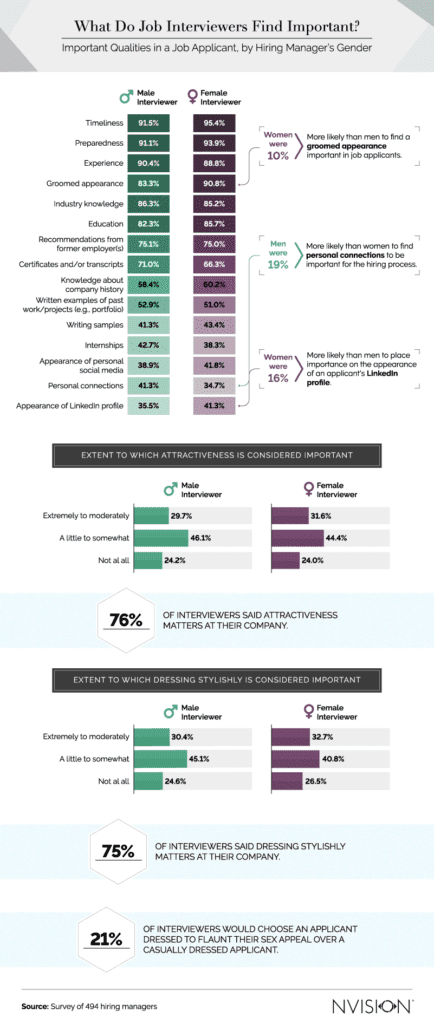
Women were 10% more likely than men to find a groomed appearance important in job applicants. Women are often assessed by their personal appearance, and it can make a difference in how they’re viewed, so perhaps this stance is an extension of how they view others applying for a job at their company.
We also inquired about whether hiring managers considered attractiveness and dressing well to be company assets. Responses were telling. About 25% noted that attractiveness does not matter at all at their company, while 75% of respondents rated dressing stylishly as important to their company.
While not everyone works in the medical field, research has shown that patients often consider how a physician dresses and its impact on their satisfaction with the care they receive, so it’s not a stretch to understand that dressing well usually indicates a level of professionalism, no matter what industry you’re in.
What Do Interviewers Look Down On?
There were a few red flags that stuck out to respondents when they reflected on the interview process. Body odor, loungewear, and casual clothes, such as jeans and a T-shirt, were the three biggest negative interview qualities.
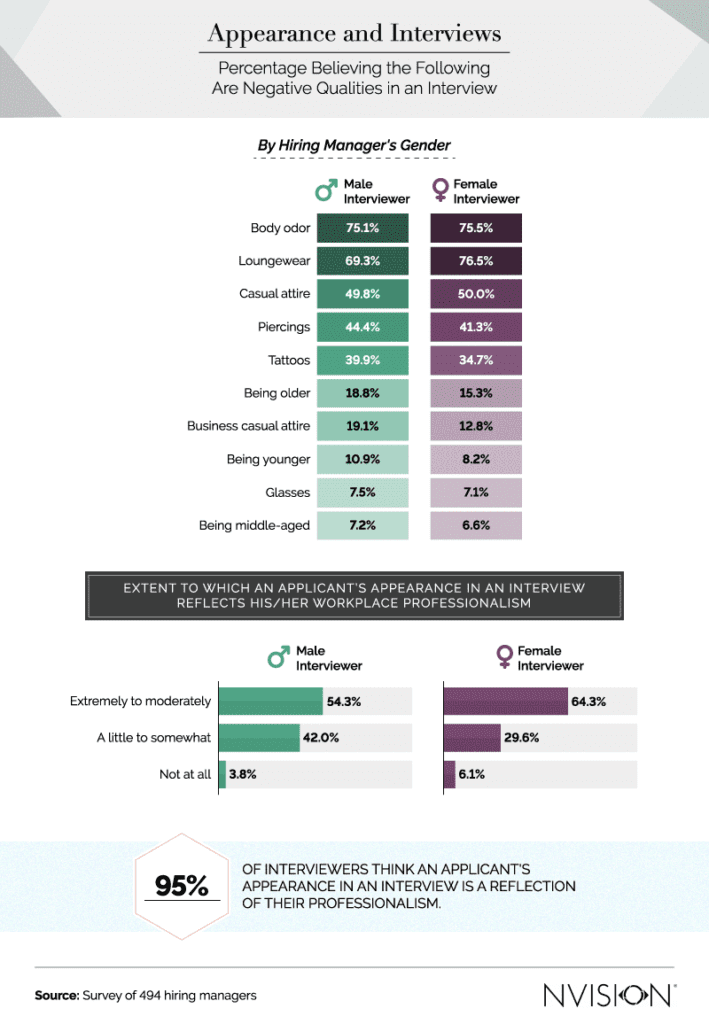
Tattoos and piercings appeared next on the list. Visible body modification in the workplace has been (and remains) controversial, but it isn’t always an automatic deterrent with hiring managers. In fact, less than half of hiring managers felt it was a negative quality in a potential employee, although it was more of an issue for men than women.
We also wanted to know if hiring managers felt an applicant’s appearance at their interview reflected their workplace professionalism. Those who specialize in helping people find careers note the clothes a person chooses can make an impression. Most respondents agreed, and over half of men and more than 64% of women felt it moderately to extremely reflects their professionalism.
Formal vs. Casual
Do hiring managers make decisions based on how an applicant dresses when faced with other factors that make an employee a desirable candidate? The answer might surprise you. We wanted to know how hiring managers felt about a formally dressed applicant when compared to a casually dressed applicant who had better references.
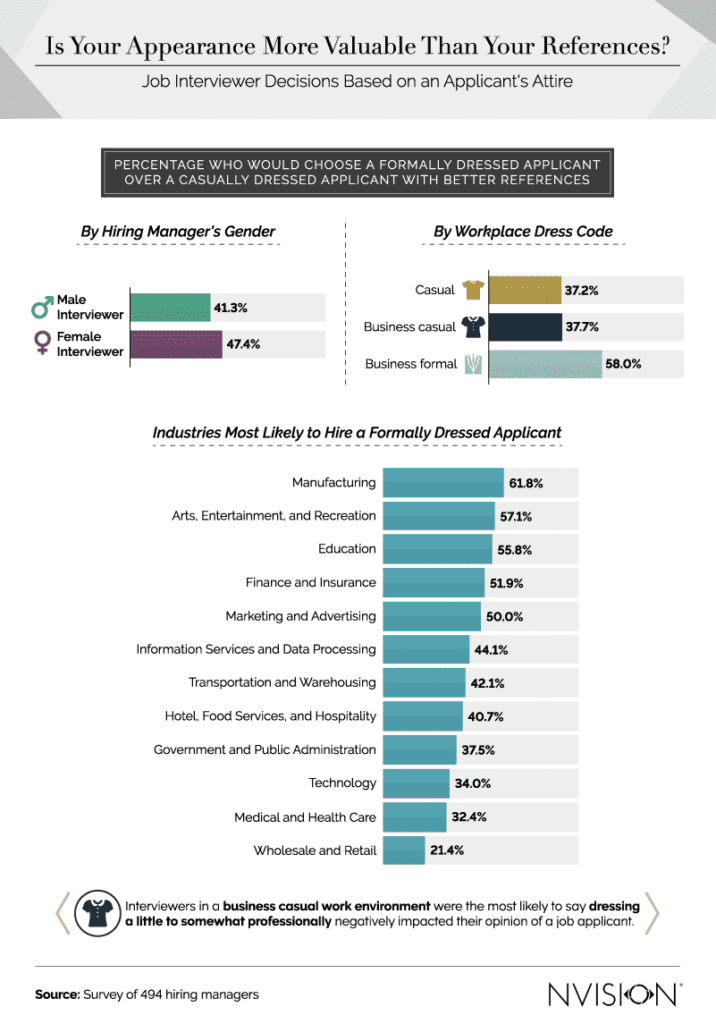
References are a crucial part of the hiring and interview process and are often contacted by hiring managers as they work to make their decision. A reference can provide a potential employer with important information about your abilities, performance, and skill set, and having a great reference could help you get a leg up on other applicants.
Our respondents, however, felt attire was more important than references overall. Over 41% of male and 47.4% of female hiring managers felt an applicant in a formal outfit would be a better fit for their company than a casually dressed counterpart – even if that person had better references.
However, answers did vary when we broke them down by workplace dress code. Those who worked in a business formal environment strongly preferred applicants who dress formally, even when another applicant in casual dress had better references. It was less of a factor for both business casual workplaces and those who allowed casual dress, where hiring managers indicated they’d be more likely to hire the person with better references.
Those in the manufacturing industry were the most likely to hire someone if they dressed formally over someone with better references, while hiring managers in wholesale and retail were less concerned about this.
What to Wear?
The burden is usually on the applicant to suss out a company’s style of dress and adorn themselves appropriately for their interview. While some experts suggest to dress up based on what you’ve discovered, we wondered if it was possible to overdress before stepping foot in the hiring manager’s office. As it turns out, close to half of our respondents said yes, it’s totally possible to dress too formally for an interview.
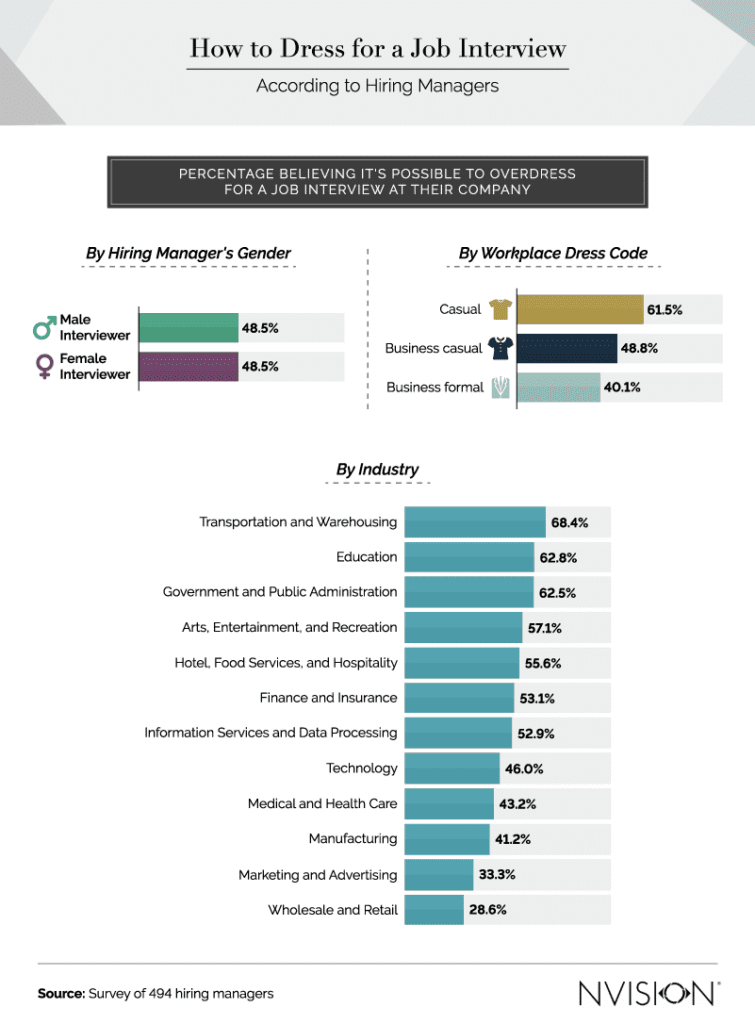
As we discovered, though, this answer does vary by a company’s workplace environment. Hiring managers in business formal environments were the least likely to agree it’s possible to overdress for an interview, while hiring managers where employees wear casual clothes were far more likely to feel overdressing is a thing.
Clothing Critics
Your appearance – while it shouldn’t really matter when it comes to performing a job competently – can make a difference when it comes to getting hired. This judgment doesn’t stop after you’ve gotten the job and signed the paperwork, either. Sixty percent of men and 63% of women indicated they judge their co-workers based on what they wear to work, and it’s especially grating for our respondents when their peers don’t follow the workplace dress code.
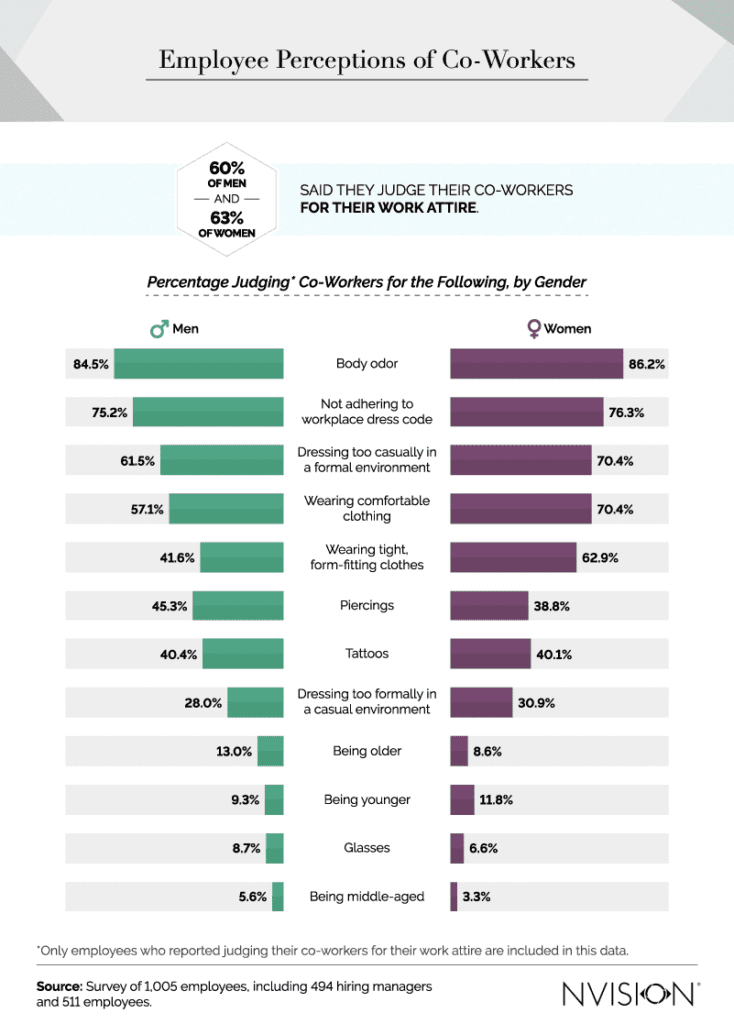
Other faux pas that brought judgment included body odor and dressing too casually in a formal environment. Less important issues included dressing too formally in a casual environment and age.
Women were more apt to judge someone for wearing tight, form-fitting clothes than men. Women often feel they’re under pressure to dress a certain way at work, which can impact their own comfort, and this pressure might affect how others dress in their work environment as well.

Most respondents agreed someone’s style and manner of dress reflects their level of professionalism, while a little over half feel how people dress at work reflects the quality of their work.

Also, over 50 percent thought a formally dressed co-worker was more productive at work than someone in the same position who dresses casually.

Management Style of Dress
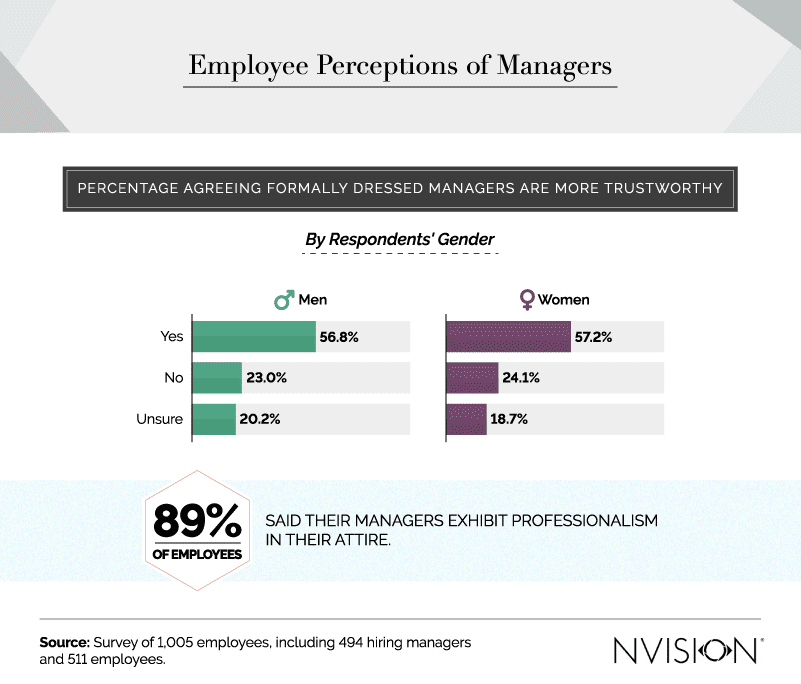
When you’re an employee and rely on management to guide your work, does the way they dress impact how you feel about them? Over half of both men and women agreed a formally dressed manager was more trustworthy than one who was casually dressed, and 89% said their managers display professionalism in the way they dress.
How one dresses can also impact their chances of personal success – dressing smartly could help with promotions, as a neat appearance gives the impression that you’re authentic and dependable, which is echoed in our findings from an employee standpoint.
Getting Ready in the A.M.
Getting ready in the morning can be a simple matter, or it can be a drawn-out process. Women tended to spend more time than men (34.7 minutes compared to 25.4 minutes) getting ready for work each day and also spent more annually on work clothes ($328) than their male counterparts ($307).
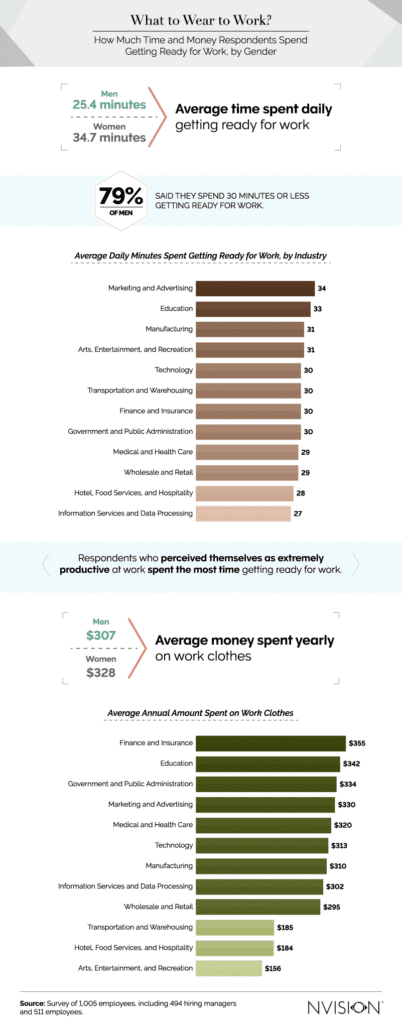
We found those in the marketing and advertising industry spent the most amount of time to get ready for work. While not every marketing and advertising position requires facing clients, it’s still often a part of the job for many in this industry, so it’s not surprising these employees wish to look as put-together as possible before heading out the door. Information services and data processing jobs don’t require a lot of time spent in the view of clients, so it’s not shocking they came in last.
There were a few industry-specific differences as far as how much money was spent on clothing every year as well. Those in the finance and insurance industry came out on top spot here, while those in the arts, entertainment, and recreation industries came in on the low side. Finance jobs are usually business formal in attire, so it’s not a stretch that those in the industry spend a lot of money on their clothing.
Dress Well and Get That Job
Many people feel that what you choose to wear, at a job interview and beyond, is a reflection of your professionalism. Take note of the workplace environment before stepping out to an interview, and see if you can get any information from other employees about the standard workplace style of dress. Often, if you feel put-together and confident – in clothing suited for your dream job – it can possibly translate into a job offer.
For those with cataracts or limited vision, taking visual cues from hiring managers and co-workers can be more challenging over time. NVISION is a network of physicians and medical professionals dedicated to improving lives by restoring sight, one patient at a time. We offer affordable and individualized treatment solutions designed to help clients thrive in their daily life. Explore our services today to learn how we can help you see beauty better.
Methodology and Limitations
For this project, we surveyed a total of 1,005 employees: 494 employees whose job responsibilities involve interviewing job applicants for their employer, and 511 employees. Of the 1,005 employees, 56.1% identified as men, and 43.9% identified as women. Respondents ranged in age from 18 to 74 years with an average age of 36.1 and a standard deviation of 10.3.
In our survey, industries were distributed as follows: 142 employees worked in finance and insurance; 102 worked in education; 99 worked in technology; 93 in medical and health care; 72 in wholesale and retail; 62 in information services and data processing; 60 in hotel, food services, and hospitality; 55 in arts, entertainment, and recreation; 44 in government and public administration; 41 in transportation and warehousing; and 29 employees worked in marketing and advertising.
The following industries were excluded from our data due to small sample sizes: real estate, rental, and leasing; construction; telecommunications; legal; scientific; agriculture, forestry, fishing, and hunting; military; utilities; religious; broadcasting and journalism; publishing; and mining.
To compare average minutes spent getting ready for work and the amount of money spent on work clothes by industry, we excluded outliers.
The data rely on self-reporting by respondents, no statistical testing was performed.
Fair Use Statement
Do you want to share these findings on dressing for the workplace? The graphics and information found on this website are available for noncommercial reuse, but please make sure to link back to this page. Thank you!
Sources
- https://www.ncbi.nlm.nih.gov/pmc/articles/PMC5749813/
- https://fox43.com/2018/05/01/does-appearance-play-a-role-in-the-success-of-women-in-the-workplace/
- https://www.cpbj.com/corporate-ink-perception-of-tattoos-in-the-workplace-is-changing/
- https://www.cnbc.com/2018/03/05/suzy-welch-how-to-dress-for-a-job-interview-in-2018.html
- https://easttennessean.com/2018/11/18/womens-professional-attire-sexist-compared-to-the-male-expectation/
- https://www.forbes.com/sites/victorlipman/2018/06/08/how-your-clothes-can-help-you-get-promoted/#4b2c9df57e47
- https://career.du.edu/blog/2018/01/22/professional-attire-basics/
- https://www.colorado.edu/today/2019/03/25/attractive-businesswomen-viewed-less-truthful-more-fireable-femme-fatales-new-research
- https://www.ncbi.nlm.nih.gov/pmc/articles/PMC6305720/
- https://www.ncbi.nlm.nih.gov/pmc/articles/PMC5988098/
- https://career.fsu.edu/sites/g/files/upcbnu746/files/Dressing%20to%20Impress%20revise_0.pdf
- https://www.tandfonline.com/doi/abs/10.1080/00224545.2017.1393383?journalCode=vsoc20
- https://icc.ucdavis.edu/materials/references
- https://www.bu.edu/careers/networking-interviews/interviewing-the-big-picture/dress-for-the-interview/
- https://wp0.vanderbilt.edu/career/attire-etiquette/
- https://www.marquette.edu/explore/what-can-you-do-with-a-major-in-advertising.php